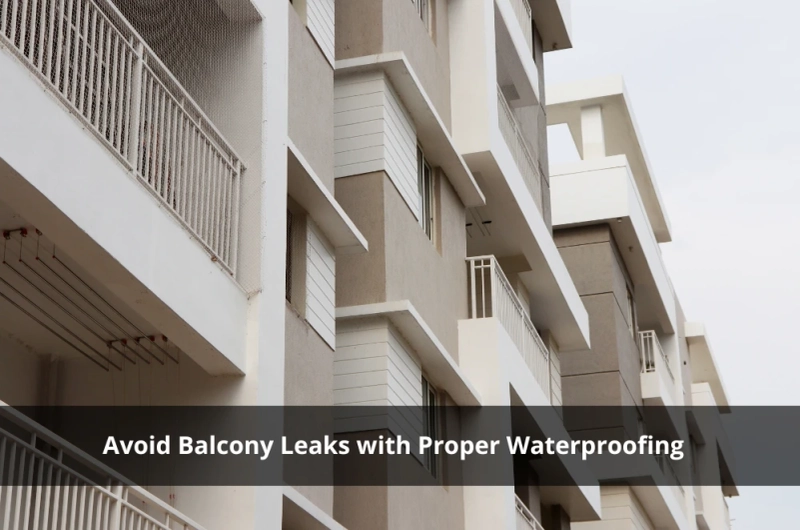When water starts seeping into your balcony tiles or pooling near exterior walls, it’s rarely a one-time event. More often, it’s a sign of deeper issues — usually with the original waterproofing balcony system. And the longer it's left unchecked, the more costly and invasive the repairs become.
Whether you’re building new, renovating, or just starting to notice suspicious water stains, here’s what you need to know about balcony waterproofing and how to avoid costly mistakes.
Why balcony waterproofing often gets overlooked
It’s strange, isn’t it? People will spend tens of thousands upgrading their kitchen or redoing their floors, but when it comes to the balcony — which is constantly exposed to rain, sun, and temperature shifts — waterproofing is often rushed or left out entirely.
Here’s why it happens:
- Balconies often look “fine” until the damage is well advanced
- Waterproofing layers are hidden, so shortcuts go unnoticed
- Builders sometimes treat outdoor areas like indoor ones — and that’s a big mistake
- Homeowners don’t always know what to ask or check for
The result? Leaks that show up a year or two later, usually after a big storm, slowly destroy substructures beneath the tiles.
Common signs your balcony is leaking
Not every leak gushes. Most start subtly. A stain here, a soft spot there — and then things get worse.
Watch for:
- Efflorescence (white powdery residue on tiles or grout)
- Cracking grout or lifting tiles
- Mould or musty smells near doors or windows
- Paint bubbling on adjoining interior walls
- Damp carpet or flooring near the balcony entry
- Rusting or corrosion on balustrade fixings
If you're unsure whether these are warning signs, check out our guide on common waterproofing mistakes, especially if you’re working with a builder or buying a new property.
The hidden cost of poor waterproofing
I’ve worked on dozens of balcony repair jobs over the years, and the thing they all have in common is this: what looked like a small issue turned out to be a massive one once we pulled up the tiles.
We’re talking:
- Rotted joists and timber frames
- Concrete slabs with water ingress
- Rusted steel reinforcements
- Internal mould spread from outside moisture
- Tiling that had to be completely removed and re-laid
And the worst part? Most of this damage isn’t covered by insurance if it’s deemed preventable or due to poor workmanship. That means the homeowner is left footing the bill.
What proper waterproofing actually involves
Waterproofing isn’t just about slapping down a membrane and hoping for the best. It’s a system — and every step needs to be done right.
A good waterproofing job typically includes:
- Proper substrate preparation — clean, dry, and primed
- Two coats of a compatible waterproof membrane, with the correct dry time between coats
- Seamless application across joins, corners, and edges
- Correct drainage and fall so water flows away from the property
- Protective layers like screed or tiling are installed only after the membrane has cured.
For multi-storey buildings or balconies above living spaces, the standard is even higher. Compliance with the waterproofing building code in NSW is critical — both legally and structurally.
Case study: The cost of a shortcut
A client in Western Sydney called after discovering bubbling paint on their living room ceiling — just below the upstairs balcony. At first glance, it looked like a minor cosmetic issue.
But once we started investigating, we found the original builder had used an indoor membrane product — not suitable for exterior use — and skipped priming the slab entirely. Over time, water had penetrated through hairline cracks and soaked the concrete.
The repair involved stripping tiles, grinding back the slab, applying a proper membrane system, and retiling. The total cost? Over $18,000.
A proper job during the build would’ve cost less than a tenth of that.
DIY vs professional waterproofing: know the limits
While it might be tempting to try waterproofing yourself — especially if you’re handy or working on a budget — balconies are not the place to cut corners.
Here’s why:
- Most membranes are specialist products that require exact prep
- Australian Standards require licensed applicators for certain works
- Poorly applied membranes often fail within 12–24 months
- Warranty protection is usually void without a licensed install
A licensed professional not only ensures the work meets building codes — they also understand how waterproofing interacts with structural elements, drainage systems, and tile adhesives.
Prevention is cheaper than repair
Here’s the hard truth: balcony leaks are always more expensive to fix than to prevent. Once water gets into concrete or framing, the repairs often involve major demolition, structural assessment, and reconstruction.
If you’re building or renovating, speak up early. Ask your builder:
- What waterproofing system will be used?
- Is the product suitable for external use and UV exposure?
- How is drainage handled — and where does the water go?
- Are membranes applied by a licensed technician?
If you already have a balcony and are worried about signs of water damage, consider a detailed inspection and moisture test before the next wet season.
Want more day-to-day upkeep tips? This guide on balcony leak prevention tips offers simple routines to spot trouble before it spreads.
Final word: Your balcony deserves better
Too often, balconies are treated as an afterthought — a nice outdoor space that doesn’t get the same attention as the inside of your home. But they’re exposed to far harsher conditions, and any failure in waterproofing can be both costly and dangerous.
If you’re seeing signs of moisture or planning work that involves tiling or sealing your balcony, take the time to do it properly. Choose quality products, licensed professionals, and don’t rush the prep work.
Water doesn’t wait. And balconies don’t fix themselves.



